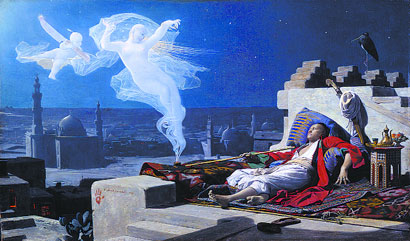The Dahesh Museum of Art presents retrospective on Jean Lecomte du Nouÿ
Painted in what might be called high-definition style, Jean Lecomte du Nouÿ’s “The Gate of the Harem: Souvenir of Cairo” depicts six dark-skinned guards in desert garb reclining on rugs and pillows at dawn outside the harem of a Muslim palace. Armed to the teeth with sabers and ornately decorated muskets, they evidently spent the night wide awake under the stars. One smokes a hookah. Worn slippers and the soft folds of a cast-off turban litter the foreground; a crescent moon floats over pink-tinted minarets in the distance. Realistic yet an invented fantasy, the placid scene belies a potent brew of cultural cross-currents and political controversy in its own time, the late 19th century.
For “The Gate of the Harem” is a painting in the academic-style that dates from 1876 Paris when Impressionism was well underway. It now belongs to Collection Yves Saint Laurent—Pierre Bergé, Paris. Until September 19, this and other works by a fascinating but forgotten contemporary of Cezanne and Monet are on view at the Dahesh Museum.
Lecomte du Nouÿ’s oeuvre is thoroughly discussed in Roger Diederen’s scholarly catalogue for the exhibition. Diederen sees the painter within a much wider context of academic painting in European culture, and deftly unravels circuitous connections between 19th century French painting, its literary sources and innovations in the new science of archaeology. Egyptology in particular carried interesting cultural and political meanings. Lots of glossy color reproductions in the catalogue illustrate Diederen’s points and are helpful, particularly since Lecomte du Nouÿ’s works will be returned to far-flung collections when the show closes.
If you miss it, there’s more where that came from. The sole mission of the Dahesh Museum, now located in the spiffy IBM building at 57th Street and Madison Avenue, is to exhibit academic art. Originally conceived in 1975 by Dr. Dahesh, the pen name of Salim Moussa Achi of Lebanon, as a museum that would have had its home in Beirut, his collection landed in New York City instead. Favoring depictions of the Arab world, this museum of academic art is ripe to take on a new context in the 21st century.



































